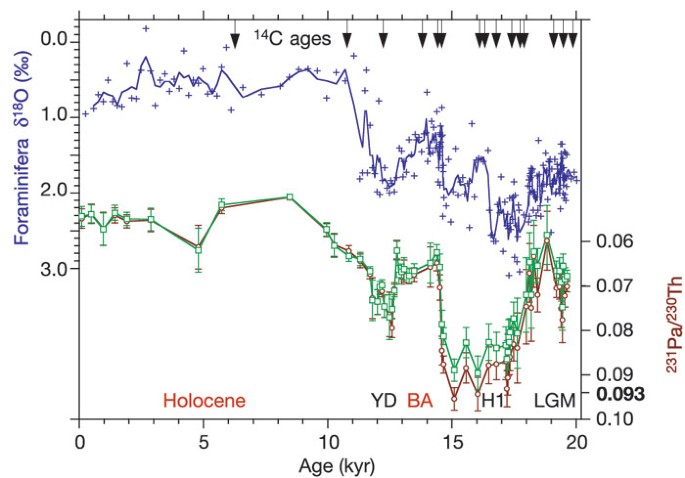ding
Confront reality
- Oct 25, 2016
- 121,358
- 21,498
The most recent ice age was characterized by rapid and hemispherically asynchronous climate oscillations, whose origin remains unresolved. Variations in oceanic meridional heat transport may contribute to these repeated climate changes, which were most pronounced during marine isotope stage 3, the glacial interval 25 thousand to 60 thousand years ago. We examined climate and ocean circulation proxies throughout this interval at high resolution in a deep North Atlantic sediment core, combining the kinematic tracer protactinium/thorium (Pa/Th) with the deep water-mass tracer, epibenthic δ13C. These indicators suggest reduced Atlantic overturning circulation during every cool northern stadial, with the greatest reductions during episodic Hudson Strait iceberg discharges, while sharp northern warming followed reinvigorated overturning. These results provide direct evidence for the ocean’s persistent, central role in abrupt glacial climate change.Quotes. I'd like to see quotes. And if you can't find them and you're a grown up with any ethics whatsoever, an admission that you can't locate any if that's the case.
The last ice age wasn't one long big chill. Dozens of times temperatures abruptly rose or fell, causing all manner of ecological change. Mysteriously, ice cores from Greenland and Antarctica show that these sudden shifts—which occurred every 1500 years or so—were out of sync in the two hemispheres: When it got cold in the north, it grew warm in the south, and vice versa. Now, scientists have implicated the culprit behind those seesaws—changes to a conveyor belt of ocean currents known as the Atlantic Meridional Overturning Circulation (AMOC).
These currents, which today drive the Gulf Stream, bring warm surface waters north and send cold, deeper waters south. But they weakened suddenly and drastically, nearly to the point of stopping, just before several periods of abrupt climate change, researchers report today in Science. In a matter of decades, temperatures plummeted in the north, as the currents brought less warmth in that direction. Meanwhile, the backlog of warm, southern waters allowed the Southern Hemisphere to heat up.
MOC Aslowdowns have long been suspected as the cause of the climate swings during the last ice age, which lasted from 110,000 to 15,000 years ago, but never definitively shown. The new study "is the best demonstration that this indeed happened," says Jerry McManus, a paleo-oceanographer at Columbia University's Lamont-Doherty Earth Observatory, and a study author. "It is very convincing evidence," adds Andreas Schmittner, a climate scientist at Oregon State University, Corvallis. "We did not know that the circulation changed during these shorter intervals."
The Atlantic meridional overturning circulation is widely believed to affect climate. Changes in ocean circulation have been inferred from records of the deep water chemical composition derived from sedimentary nutrient proxies1, but their impact on climate is difficult to assess because such reconstructions provide insufficient constraints on the rate of overturning2. Here we report measurements of 231Pa/230Th, a kinematic proxy for the meridional overturning circulation, in a sediment core from the subtropical North Atlantic Ocean. We find that the meridional overturning was nearly, or completely, eliminated during the coldest deglacial interval in the North Atlantic region, beginning with the catastrophic iceberg discharge Heinrich event H1, 17,500 yr ago, and declined sharply but briefly into the Younger Dryas cold event, about 12,700 yr ago. Following these cold events, the 231Pa/230Th record indicates that rapid accelerations of the meridional overturning circulation were concurrent with the two strongest regional warming events during deglaciation. These results confirm the significance of variations in the rate of the Atlantic meridional overturning circulation for abrupt climate changes.

Collapse and rapid resumption of Atlantic meridional circulation linked to deglacial climate changes - Nature
The Atlantic meridional overturning circulation is widely believed to affect climate. Changes in ocean circulation have been inferred from records of the deep water chemical composition derived from sedimentary nutrient proxies1, but their impact on climate is difficult to assess because such...